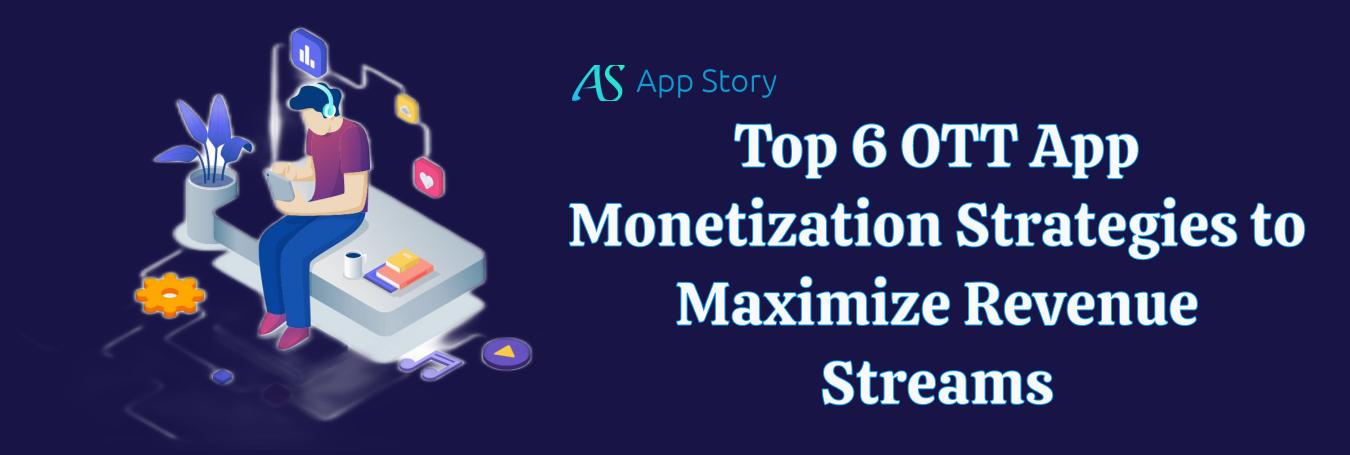As the internet-driven, multi-device ecosystem grows, so will the opportunities for OTT app development. The phrase OTT refers to detailed video on demand (VOD) and live streaming of awards programs, premieres, athletic events, concerts, and so on. Many of the biggest over-the-top (OTT) players, including Netflix, YouTube, Hulu, and Amazon Prime Video, have already put their monetization plans into action.
Over-the-top (OTT) services have developed new business models, strategies, and methods for monetizing videos in response to the shift in viewer preferences toward online video streaming. As a result, the amount of video streaming material has been rising tremendously.
The size of the global over-the-top (OTT) industry, estimated at $121.61 billion in 2019, is expected to grow at a CAGR of 29.4% to $1,039.03 billion by 2027.
Considering the recent trend of cord-cutting is likely to grow, the popularity of custom on-demand app solutions is booming, and OTT app development companies are expected to prosper even further. This creates a perfect environment for publishers to take advantage of this scenario. Companies like Q3 Technologies make sure to optimize the monetization strategies with their years of expertisein order to meet your unique goals.
This article will describe the characteristics of OTT and detail each monetization strategy used to deliver OTT content.
Top 6 OTT App Monetization Strategies to Maximize Revenue Streams
The kind of content you spend greatly influences your organization’s revenue model. The real question is which OTT business revenue model to implement based on the viewing habits of your target audience.
Subscription-Based Model (SVOD)
One of the most widely used and successful monetization techniques for over-the-top (OTT) platforms is the subscription-based video-on-demand (SVOD) model. A subscription service allows customers to access a library of information without limits in exchange for a regular payment that is often made on a monthly or annual basis. OTT platforms are able to invest in premium content and enhance user experience because of this model’s reliable and consistent revenue source.
Key Benefits:
- They provide an inexpensive monthly or annual subscription that grants you unrestricted access to their extensive assortment of video libraries.
- Additionally, SVOD gives platform users the option to cancel their membership whenever they like without being tied to a long-term agreement.
- Since subscription video on demand is auto-renewable, users can easily opt-in or opt-out at any time.
Examples: Netflix, Disney+, and Hulu utilize the SVOD model effectively, offering tiered subscription plans to cater to different user needs.
Advertising-Based Model (AVOD)
Advertising-based video on demand (AVOD) is another widely adopted strategy where users can access content for free, with the cost covered by advertisers. Users who would rather not pay for content and are open to seeing advertisements in exchange for free access find this approach appealing. For OTT platforms, AVOD can generate substantial revenue through ad placements, sponsorships, and brand partnerships.
Key Benefits:
- Advertisers pay enormous sums of money to stream their powerful advertisements on your unified top video monetization platforms.
- Additionally, you can choose your own price based on the popularity of the platform and the kind of content that is selected for the advertisement.
- Nevertheless, compared to regular TV, VOD advertisements are shown to be less expensive and have a shorter duration.
Examples: Platforms like YouTube and Peacock leverage the AVOD model, offering free content with ad interruptions.
- Transactional Model (TVOD)
The transactional video-on-demand (TVOD) model allows users to pay for individual pieces of content. Customers who would rather not commit to a membership but would still like to view particular films, series, or events can benefit from this pay-per-view option. TVOD can be split into two categories: rental (where users can access content for a limited time) and purchase (where users gain permanent access to the content).
Key Benefits:
- Customers who purchase can keep a specific piece of content on the platform or download it to their own devices, making it their property. Conversely, renting restricts the amount of time that users can utilize a piece of content.
- TVOD services should make every effort to keep consumers by providing enticing pricing and exclusive discounts on a particular piece of content. The audience can then quickly scan the most recent releases and profit from the market’s current buzz.
Examples: iTunes and Amazon Prime Video offer TVOD services, allowing users to rent or buy individual movies and shows.
Hybrid Model
The hybrid model combines elements of SVOD, AVOD, and TVOD, providing users with multiple options to access content. OTT platforms can offer a variety of subscription plans, pay-per-view alternatives, and free content backed by advertisements. By doing this, they are able to maximize revenue from a variety of user categories and reach a larger target base.
Key Benefits:
- Some of the greatest benefits of merging these various video monetization strategies are the availability of visually appealing content to a larger audience with a range of potentialities and financial interests.
- Wider user bases also lead to larger revenue potential, creating opportunities for new revenue streams.
Examples: Hulu and Amazon Prime Video employ hybrid models, offering a combination of subscription plans, ad-supported content, and transactional options.
Freemium Model
The freemium model provides basic content access for free while offering premium content or features for a fee. With this strategy, OTT platforms can draw in a sizable user base by offering free content, and a percentage of those users can later be converted into paying subscribers for premium access. Features like ad-free viewing, access to exclusive content, or first dibs on new releases are frequently included in freemium models.
Key Benefits:
- Free content helps attract and retain a large user base.
- Offers a pathway to convert free users into paying subscribers.
- Differentiates between free and premium content to incentivize upgrades.
Examples: Spotify and Crunchyroll use the freemium model, providing free access with optional premium subscriptions for enhanced features.
- Sponsorship and Partnership Deals
Sponsorship and partnership deals involve collaborating with brands, influencers, or other content creators to produce sponsored content or co-branded series. This strategy can generate additional revenue and enhance the platform’s content library through high-quality, sponsored programming. These deals can also include product placements, branded content, or exclusive partnerships that attract new audiences.
Key Benefits:
- Coupons, whether or not they are used, increase brand recognition. Buyers may use the discount to join up for your OTT streaming service, but you can still upsell them if you can convince them to interact with your content.
- Track the number of coupons utilized with different codes to determine how successful your promotions were.
Examples: Netflix’s partnership with celebrities for exclusive series and YouTube’s influencer collaborations demonstrate the potential of sponsorship and partnership deals.
Conclusion
The worldwide consumer consumption patterns have undergone a substantial transformation, which presents an opportunity for all OTT app development companies, irrespective of their size, budget, or industry.
An OTT app’s monetization strategy must be carefully considered in light of the platform’s content offers and target demographic. OTT platforms can optimize their income streams and maintain long-term growth by utilizing a combination of subscription-based, advertising-based, transactional, hybrid, freemium, and sponsorship models. Optimizing these monetization techniques and maintaining competitiveness in the always-changing OTT landscape requires a thorough understanding of user preferences and behaviors.






 United States
United States United Kingdom
United Kingdom India
India Canada
Canada Singapore
Singapore















![10 Benefits of the Internet of Things You Should Know [2025]](https://www.appstory.org/wp-content/uploads/2025/03/ATS-10-Benefits-of-the-Internet-of-Things-You-Should-Know-2025@2x-80x60.png)




















